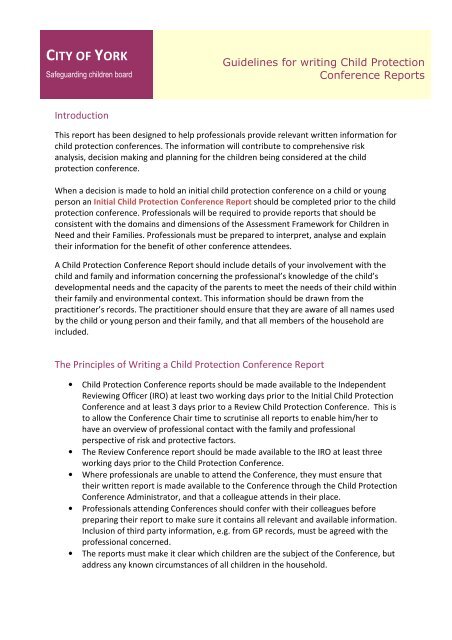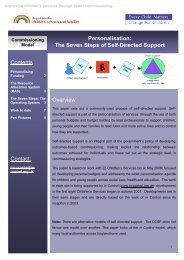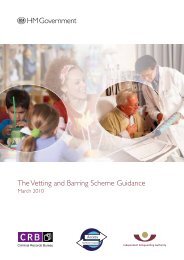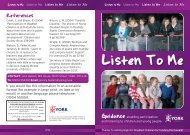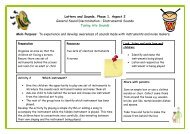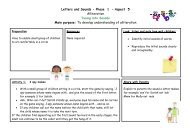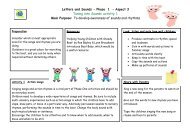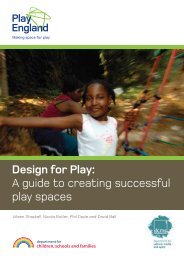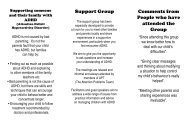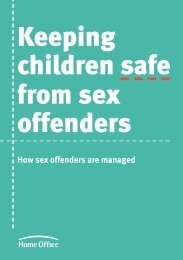Guidance on writing Child Protection Conference reports
Guidance on writing Child Protection Conference reports
Guidance on writing Child Protection Conference reports
You also want an ePaper? Increase the reach of your titles
YUMPU automatically turns print PDFs into web optimized ePapers that Google loves.
CITY OF YORKSafeguarding Introducti<strong>on</strong> children boardGuidelines for <strong>writing</strong> <strong>Child</strong> Protecti<strong>on</strong>C<strong>on</strong>ference ReportsIntroducti<strong>on</strong>This report has been designed to help professi<strong>on</strong>als provide relevant written informati<strong>on</strong> forchild protecti<strong>on</strong> c<strong>on</strong>ferences. The informati<strong>on</strong> will c<strong>on</strong>tribute to comprehensive riskanalysis, decisi<strong>on</strong> making and planning for the children being c<strong>on</strong>sidered at the childprotecti<strong>on</strong> c<strong>on</strong>ference.When a decisi<strong>on</strong> is made to hold an initial child protecti<strong>on</strong> c<strong>on</strong>ference <strong>on</strong> a child or youngpers<strong>on</strong> an Initial <strong>Child</strong> Protecti<strong>on</strong> C<strong>on</strong>ference Report should be completed prior to the childprotecti<strong>on</strong> c<strong>on</strong>ference. Professi<strong>on</strong>als will be required to provide <strong>reports</strong> that should bec<strong>on</strong>sistent with the domains and dimensi<strong>on</strong>s of the Assessment Framework for <strong>Child</strong>ren inNeed and their Families. Professi<strong>on</strong>als must be prepared to interpret, analyse and explaintheir informati<strong>on</strong> for the benefit of other c<strong>on</strong>ference attendees.A <strong>Child</strong> Protecti<strong>on</strong> C<strong>on</strong>ference Report should include details of your involvement with thechild and family and informati<strong>on</strong> c<strong>on</strong>cerning the professi<strong>on</strong>al’s knowledge of the child’sdevelopmental needs and the capacity of the parents to meet the needs of their child withintheir family and envir<strong>on</strong>mental c<strong>on</strong>text. This informati<strong>on</strong> should be drawn from thepractiti<strong>on</strong>er’s records. The practiti<strong>on</strong>er should ensure that they are aware of all names usedby the child or young pers<strong>on</strong> and their family, and that all members of the household areincluded.The Principles of Writing a <strong>Child</strong> Protecti<strong>on</strong> C<strong>on</strong>ference Report• <strong>Child</strong> Protecti<strong>on</strong> C<strong>on</strong>ference <strong>reports</strong> should be made available to the IndependentReviewing Officer (IRO) at least two working days prior to the Initial <strong>Child</strong> Protecti<strong>on</strong>C<strong>on</strong>ference and at least 3 days prior to a Review <strong>Child</strong> Protecti<strong>on</strong> C<strong>on</strong>ference. This isto allow the C<strong>on</strong>ference Chair time to scrutinise all <strong>reports</strong> to enable him/her tohave an overview of professi<strong>on</strong>al c<strong>on</strong>tact with the family and professi<strong>on</strong>alperspective of risk and protective factors.• The Review C<strong>on</strong>ference report should be made available to the IRO at least threeworking days prior to the <strong>Child</strong> Protecti<strong>on</strong> C<strong>on</strong>ference.• Where professi<strong>on</strong>als are unable to attend the C<strong>on</strong>ference, they must ensure thattheir written report is made available to the C<strong>on</strong>ference through the <strong>Child</strong> Protecti<strong>on</strong>C<strong>on</strong>ference Administrator, and that a colleague attends in their place.• Professi<strong>on</strong>als attending C<strong>on</strong>ferences should c<strong>on</strong>fer with their colleagues beforepreparing their report to make sure it c<strong>on</strong>tains all relevant and available informati<strong>on</strong>.Inclusi<strong>on</strong> of third party informati<strong>on</strong>, e.g. from GP records, must be agreed with theprofessi<strong>on</strong>al c<strong>on</strong>cerned.• The <strong>reports</strong> must make it clear which children are the subject of the C<strong>on</strong>ference, butaddress any known circumstances of all children in the household.
For it to be effective it needs to be: Comprehensive Succinct (of manageable size to absorb the informati<strong>on</strong>) Each entry should be no more than two lines Date of the Event Births and Deaths Diagnoses of disability/difficulties Referrals to and from other services. Attendances at appointments where referrals have been made and DNA’s Attendances at A&E No Access visits (if significant) Assessment of Mental Health Hospital Admissi<strong>on</strong>s Divorce/Separati<strong>on</strong> Discussi<strong>on</strong>s with other professi<strong>on</strong>als, especially if raised c<strong>on</strong>cerns or otherissues. Changes in observati<strong>on</strong>s of parenting or relati<strong>on</strong>ship. This implies the firstobservati<strong>on</strong> must be recorded to give a baseline. C<strong>on</strong>tain both risk and protective factors Changes of address or nursery, school etc(the above are examples and not an exhaustive list)The assessment frameworkThe subsequent secti<strong>on</strong>s of the report gather informati<strong>on</strong> <strong>on</strong> the child or young pers<strong>on</strong>’sneeds, parenting capacity and family and envir<strong>on</strong>mental factors.These secti<strong>on</strong>s record the child or young pers<strong>on</strong>’s views and separately, those ofparents/main carers regarding the c<strong>on</strong>cerns that led to an initial child protecti<strong>on</strong> casec<strong>on</strong>ference being held. Need to add in professi<strong>on</strong>al observati<strong>on</strong>s, analysis etc. It should alsoidentify the acti<strong>on</strong>(s) the child or young pers<strong>on</strong> and parents and you as a professi<strong>on</strong>albelieve should be taken.<strong>Child</strong>’s Developmental needs: Provide informati<strong>on</strong> about each child including the child/ren’scurrent and past developmental attainments, and observati<strong>on</strong>s of peer / familialinteracti<strong>on</strong>s / relati<strong>on</strong>ships, in comparis<strong>on</strong> with what would be expected of a child of asimilar age.Health professi<strong>on</strong>als should include any health or developmental assessments. Recordheight/weight/head circumference percentiles and state whether this is within the normalor expected parameters for that child.Educati<strong>on</strong> professi<strong>on</strong>als should include a record of school attendance and educati<strong>on</strong>alattainment.Parenting Capacity: C<strong>on</strong>sider Basic Care, ensuring safety, emoti<strong>on</strong>al warmth, stimulati<strong>on</strong>,guidance and boundaries and stability. Include your views <strong>on</strong> whether the family soughtprofessi<strong>on</strong>al advice / support appropriately, whether they have worked in partnership with
you and / or shown a willingness to implement advice and whether they regularly keepappointments madeWider Family and envir<strong>on</strong>mental factors: C<strong>on</strong>sider family history and functi<strong>on</strong>ing, widerfamily, housing, employment, budgetary management, social integrati<strong>on</strong> and communityresources.Analysis/Assessment of RiskAnalyse the informati<strong>on</strong> gathered and identify the implicati<strong>on</strong>s for the child or youngpers<strong>on</strong>’s future safety, health and development.This should include c<strong>on</strong>siderati<strong>on</strong> of;• Comments of the child/young pers<strong>on</strong>• Comments of parents/main carers.• Those factors that increase the level of identified risk to the children and causec<strong>on</strong>cerns should be recorded, al<strong>on</strong>gside those factors which may help to minimiserisk. Risk factors also to be c<strong>on</strong>sidered are; the impact of a parent’s mental ill health,learning disabilities, substance misuse or domestic abuse.• All identified risk and protective factors must be evidence based, and the reas<strong>on</strong> forprofessi<strong>on</strong>al opini<strong>on</strong> (e.g. about the quality of attachment) must be clearlydocumented within your report.• Include your professi<strong>on</strong>al opini<strong>on</strong> about whether the child/children should be madethe subject of a <strong>Child</strong> Protecti<strong>on</strong> Plan, based <strong>on</strong> the knowledge available to you atthe time of <strong>writing</strong> the report. You can give an alternative view in the c<strong>on</strong>ference ifyour view changes based up<strong>on</strong> other informati<strong>on</strong> shared at the meeting.When the practiti<strong>on</strong>er has completed the Initial/Review <strong>Child</strong> Protecti<strong>on</strong> C<strong>on</strong>ferenceReport, the professi<strong>on</strong>al should, in so far is c<strong>on</strong>sistent with the safety of the child or youngpers<strong>on</strong>, share the report with parents, and with the child / young pers<strong>on</strong>, if of sufficient ageand understanding.At the <strong>Child</strong> Protecti<strong>on</strong> C<strong>on</strong>ference you will be asked to give a brief summary of your report,being open to questi<strong>on</strong> and challenge from other professi<strong>on</strong>als, and you will also beexpected to give an opini<strong>on</strong> as to the need for a <strong>Child</strong> Protecti<strong>on</strong> Plan.The final report should be signed and dated by the practiti<strong>on</strong>er and his or her manager.Please note that the City of York Safeguarding <strong>Child</strong>ren Board run courses entitled‘C<strong>on</strong>tributing Effectively in <strong>Child</strong> Protecti<strong>on</strong> Processes’. All staff whose role involvesattending <strong>Child</strong> Protecti<strong>on</strong> C<strong>on</strong>ferences are advised to attend this course to enable effectivemulti-agency workingFor further informati<strong>on</strong>, please visit www.saferchildrenyork.org.uk


